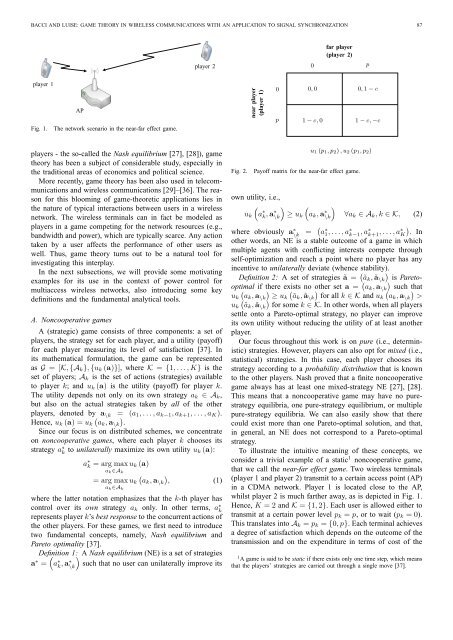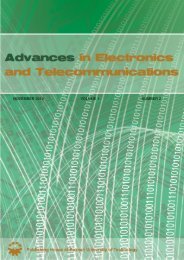channel - Advances in Electronics and Telecommunications
channel - Advances in Electronics and Telecommunications
channel - Advances in Electronics and Telecommunications
You also want an ePaper? Increase the reach of your titles
YUMPU automatically turns print PDFs into web optimized ePapers that Google loves.
BACCI AND LUISE: GAME THEORY IN WIRELESS COMMUNICATIONS WITH AN APPLICATION TO SIGNAL SYNCHRONIZATION 87<br />
player 1<br />
AP<br />
Fig. 1. The network scenario <strong>in</strong> the near-far effect game.<br />
player 2<br />
players - the so-called the Nash equilibrium [27], [28]), game<br />
theory has been a subject of considerable study, especially <strong>in</strong><br />
the traditional areas of economics <strong>and</strong> political science.<br />
More recently, game theory has been also used <strong>in</strong> telecommunications<br />
<strong>and</strong> wireless communications [29]–[36]. The reason<br />
for this bloom<strong>in</strong>g of game-theoretic applications lies <strong>in</strong><br />
the nature of typical <strong>in</strong>teractions between users <strong>in</strong> a wireless<br />
network. The wireless term<strong>in</strong>als can <strong>in</strong> fact be modeled as<br />
players <strong>in</strong> a game compet<strong>in</strong>g for the network resources (e.g.,<br />
b<strong>and</strong>width <strong>and</strong> power), which are typically scarce. Any action<br />
taken by a user affects the performance of other users as<br />
well. Thus, game theory turns out to be a natural tool for<br />
<strong>in</strong>vestigat<strong>in</strong>g this <strong>in</strong>terplay.<br />
In the next subsections, we will provide some motivat<strong>in</strong>g<br />
examples for its use <strong>in</strong> the context of power control for<br />
multiaccess wireless networks, also <strong>in</strong>troduc<strong>in</strong>g some key<br />
def<strong>in</strong>itions <strong>and</strong> the fundamental analytical tools.<br />
A. Noncooperative games<br />
A (strategic) game consists of three components: a set of<br />
players, the strategy set for each player, <strong>and</strong> a utility (payoff)<br />
for each player measur<strong>in</strong>g its level of satisfaction [37]. In<br />
its mathematical formulation, the game can be represented<br />
as G = [K, {Ak}, {uk (a)}], where K = {1, . . . , K} is the<br />
set of players; Ak is the set of actions (strategies) available<br />
to player k; <strong>and</strong> uk (a) is the utility (payoff) for player k.<br />
The utility depends not only on its own strategy ak ∈ Ak,<br />
but also on the actual strategies taken by all of the other<br />
players, denoted by a \k = (a1, . . . , ak−1, ak+1, . . . , aK).<br />
Hence, uk (a) = uk<br />
� �<br />
ak, a \k .<br />
S<strong>in</strong>ce our focus is on distributed schemes, we concentrate<br />
on noncooperative games, where each player k chooses its<br />
strategy a ∗ k to unilaterally maximize its own utility uk (a):<br />
a ∗ k<br />
= arg max uk (a)<br />
ak∈Ak<br />
= arg max uk<br />
ak∈Ak<br />
� �<br />
ak, a \k , (1)<br />
where the latter notation emphasizes that the k-th player has<br />
control over its own strategy ak only. In other terms, a ∗ k<br />
represents player k’s best response to the concurrent actions of<br />
the other players. For these games, we first need to <strong>in</strong>troduce<br />
two fundamental concepts, namely, Nash equilibrium <strong>and</strong><br />
Pareto optimality [37].<br />
Def<strong>in</strong>ition 1: A Nash equilibrium (NE) is a set of strategies<br />
a∗ � �<br />
= such that no user can unilaterally improve its<br />
a ∗ k , a∗ \k<br />
near player<br />
(player 1)<br />
0<br />
p<br />
0<br />
far player<br />
(player 2)<br />
0, 0 0, 1 − c<br />
1 − c, 0 1 − c, −c<br />
p<br />
u1 (p1, p2) , u2 (p1, p2)<br />
Fig. 2. Payoff matrix for the near-far effect game.<br />
own utility, i.e.,<br />
�<br />
uk a ∗ k , a∗ �<br />
\k ≥ uk<br />
�<br />
ak, a ∗ �<br />
\k<br />
∀ak ∈ Ak, k ∈ K, (2)<br />
where obviously a∗ \k = � a∗ 1, . . . , a∗ k−1 , a∗ k+1 , . . . , a∗ �<br />
K . In<br />
other words, an NE is a stable outcome of a game <strong>in</strong> which<br />
multiple agents with conflict<strong>in</strong>g <strong>in</strong>terests compete through<br />
self-optimization <strong>and</strong> reach a po<strong>in</strong>t where no player has any<br />
<strong>in</strong>centive to unilaterally deviate (whence stability).<br />
Def<strong>in</strong>ition 2: A set of strategies ã = � �<br />
ãk, ã \k is Paretooptimal<br />
if there exists no other set a = � �<br />
� � � � ak, a \k�<br />
such � that<br />
uk ak, a \k ≥ uk ãk, ã \k for all k ∈ K <strong>and</strong> uk<br />
� � ak, a \k ><br />
uk ãk, ã \k for some k ∈ K. In other words, when all players<br />
settle onto a Pareto-optimal strategy, no player can improve<br />
its own utility without reduc<strong>in</strong>g the utility of at least another<br />
player.<br />
Our focus throughout this work is on pure (i.e., determ<strong>in</strong>istic)<br />
strategies. However, players can also opt for mixed (i.e.,<br />
statistical) strategies. In this case, each player chooses its<br />
strategy accord<strong>in</strong>g to a probability distribution that is known<br />
to the other players. Nash proved that a f<strong>in</strong>ite noncooperative<br />
game always has at least one mixed-strategy NE [27], [28].<br />
This means that a noncooperative game may have no purestrategy<br />
equilibria, one pure-strategy equilibrium, or multiple<br />
pure-strategy equilibria. We can also easily show that there<br />
could exist more than one Pareto-optimal solution, <strong>and</strong> that,<br />
<strong>in</strong> general, an NE does not correspond to a Pareto-optimal<br />
strategy.<br />
To illustrate the <strong>in</strong>tuitive mean<strong>in</strong>g of these concepts, we<br />
consider a trivial example of a static1 noncooperative game,<br />
that we call the near-far effect game. Two wireless term<strong>in</strong>als<br />
(player 1 <strong>and</strong> player 2) transmit to a certa<strong>in</strong> access po<strong>in</strong>t (AP)<br />
<strong>in</strong> a CDMA network. Player 1 is located close to the AP,<br />
whilst player 2 is much farther away, as is depicted <strong>in</strong> Fig. 1.<br />
Hence, K = 2 <strong>and</strong> K = {1, 2}. Each user is allowed either to<br />
transmit at a certa<strong>in</strong> power level pk = p, or to wait (pk = 0).<br />
This translates <strong>in</strong>to Ak = pk = {0, p}. Each term<strong>in</strong>al achieves<br />
a degree of satisfaction which depends on the outcome of the<br />
transmission <strong>and</strong> on the expenditure <strong>in</strong> terms of cost of the<br />
1 A game is said to be static if there exists only one time step, which means<br />
that the players’ strategies are carried out through a s<strong>in</strong>gle move [37].







